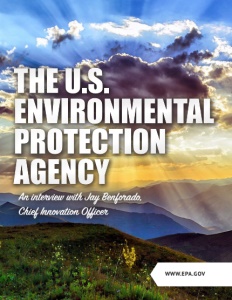The United States Environmental Protection Agency
An interview with Jay Benforado, Chief Innovation Officer
Business View Magazine: Can you tell us a little about the history of the EPA? What was in the minds of its founders? What was the need that the Environmental Protection Agency felt had to be filled? Did the mission change over the years? What is the current mandate of the EPA?
Benforado: “Concern about environmental pollution was increasing in the 1960s, and federal responsibility for environmental protection was spread across multiple agencies. Uncontrolled air pollution was a widespread problem in American cities. Water pollution caused fish die offs, contaminated drinking water, and some rivers were so polluted they caught on fire. Disposal of hazardous waste was not regulated and industrial byproducts were typically sent to unlined landfills.
“In response to this concern, the U.S. Environmental Protection Agency (EPA) was established on December 2, 1970 to consolidate in one agency a variety of federal research, monitoring, standard-setting, and enforcement activities to ensure environmental protection. A series of laws were passed by Congress that formally established today’s environmental programs. The new legislation provided a clear Congressional direction to the Agency. EPA’s core work is to develop and enforce regulations that set standards for pollution. The EPA mission has remained constant over time – to protect human health and the environment – but the work of the agency has broadened because of improved understanding of environmental science. For example, EPA has tried to shift from a framework of pollution control (dealing with pollution after it is created) to one of pollution prevention. EPA’s mandate is defined in the different laws it administers, including the Clean Air Act, Clean Water Act, Safe Drinking Water Act, Comprehensive Environmental Response, Compensation, and Liability Act, Toxics Substances Control Act, and other statutes.”
For more information on the origins and history of EPA, visit: https://www.epa.gov/history
 BVM: What types of businesses/organizations does the Environmental Protection Agency work with to facilitate its mandate?
BVM: What types of businesses/organizations does the Environmental Protection Agency work with to facilitate its mandate?
Benforado: “Environmental programs at the federal and state level issue permits that limit the amount of pollution that can be released from a facility, and conduct inspections to ensure compliance. EPA provides compliance assistance to small businesses to help facilities with similar operations comply with requirements.
“In addition to regulatory programs, EPA has voluntary partnership programs that help businesses and organizations improve environmental performance and prevent pollution. These programs encourage improved environmental performance beyond the minimum requirements and improve the overall ‘environmental footprint’ of a facility or organization. EPA’s Energy Star program, for example, helps improve energy efficiency though partnerships with home builders, appliance manufacturers, retail stores, lighting companies, and many other businesses. Additionally, EPA is one of 11 federal agencies that have a Small Business Innovation Research program that funds contracts with small businesses. EPA issues annual solicitations for Phase I and Phase II research proposals from science and technology-based firms.”
For information on EPA resources for small businesses, visit: https://www.epa.gov/resources-small-businesses
For more information on the SBIR program, visit: https://www.epa.gov/sbir
You can subscribe to email updates about the SBIR solicitations, here: https://www.epa.gov/research-grants/research-grants-fellowship-and-sbir-listserv
BVM: What is the size of the Environmental Protection Agency’s staff? What do they do? What are their main priorities? Are there any major changes planned for the near or long-term future?
Benforado: “EPA has about 14,000 employees spread across the country. Employees work on a range of topics from policy and regulation to environmental research. In laboratories across the country, scientists and engineers identify and develop solutions to environmental problems. Jobs at EPA are quite varied – with many engineers, scientists, and environmental protection specialists, as well as staff with expertise in law, communication, grants, finance, and information technology. EPA’s work is driven by environmental statutes that define EPA programs in air, water, land, and chemicals – including issuing pollution standards, permitting, enforcement, research, and public involvement. There are specific priorities that include meeting air quality standards, ensuring safety of chemicals in the marketplace, and taking faster action on priority contaminated sites. The EPA has also emphasized the importance of working collaboratively with states, local governments, and tribes to implement laws that protect human health and the environment.”
BVM: How are cities and towns in the U.S. embracing environmental sustainability initiatives? How are businesses? What are some Best Practices?
Benforado: “Many cities, in the U.S and abroad, increasingly consider social, economic, and environmental impacts in their planning and development. Cities are great real-world laboratories for applying environmental sustainability practices and testing innovative ideas, which can provide tangible benefits to residents. Many large U.S. cities are working hard on environmental sustainability issues that include housing, transportation, energy, water, and waste. Some of the successful techniques used include hosting community dialogues, setting clear measurable goals, integrating approaches into strategic planning, and carefully managing implementation. In 2016, the U.S. National Academies of Sciences issued a report titled Pathways to Urban Sustainability: Challenges and Opportunities, which can serve as a sustainability road map for cities. One major recommendation is that every city prepare its own sustainability plan and build off strategies that have gotten results in other locales, but also take unique local circumstances into account. Key lessons from this study include: sustainability planning is needed at multiple scales (from neighborhood to city to state, regional, national); that an overlooked planning priority is to reduce inequality; and that the rapid pace of societal and technological change should create a sense of urgency.
“EPA’s Brownfield Program is an example of how EPA supports environmental sustainability. The Brownfields Program provides grants and technical assistance to communities, states, and tribes to clean up and reuse contaminated properties. Land revitalization puts previously contaminated properties back into productive use. Reusing cleaned up sites protects public health and the environment by preventing sprawl, preserving green space, and reinvigorating communities.
 BVM: How can smaller cities and towns embrace sustainability?
BVM: How can smaller cities and towns embrace sustainability?
Benforado: “At EPA, the Office of Community Revitalization supports locally-led, community-driven efforts to protect the environment, expand economic opportunity, and revitalize neighborhoods. Since 2005, EPA’s technical assistance has helped hundreds of communities identify and implement strategies to achieve local priorities. One specific example is a set of grants that uses local food enterprises to support community revitalization – through a program called Local Foods, Local Places. In 2018, EPA and other partners (U.S. Department of Agriculture, Centers for Disease Control and Prevention, and the Delta Regional Authority) helped 16 communities revitalize downtowns, boost local economies, improve public health, and protect the environment through local food enterprises. This program helps communities reinvest in their neighborhoods and improve quality of life as they develop the local food economy. Since the program launched in 2014, 78 communities have developed farmers markets, community gardens, and cooperative grocery stores that improve environmental, economic, and health outcomes.”
BVM: What does the landscape look like for the private sector over the coming decade? How will the Environmental Protection Agency continue to help it protect the environment?
Benforado: “EPA and state and tribal partners are looking for new ways to engage the public and create incentives for the private sector in environmental problem solving. EPA is very interested in working with the private sector on environmental technology innovation, including continuing work on cheaper air and water sensors. EPA uses Cooperative Research and Development Agreements (CRADAs) to form research partnerships with external parties, including companies. EPA has been a leader in using challenges and prizes that are open to the public to stimulate new solutions for environmental protection, and many winners have come from the private sector. Additionally, EPA is one of 11 federal agencies that have a Small Business Innovation Research (SBIR) program that funds contracts with small businesses. Through SBIR, EPA issues annual solicitations for Phase I and Phase II research proposals from science and technology-based firms.
“Industry can play a leading role in a shift to sustainability by incorporating sustainability into their business strategies. Some companies have already made this shift and shown that bold sustainability strategies can contribute to the bottom line. Consumers also have power in creating this shift, as today, more consumers pay attention to the sustainability policies of the companies they buy products from. In addition to attracting customers, sustainability strategies can help companies attract employees and investors, reduce operating costs, and encourage innovation and creativity.”
For more information on EPA’s challenges and prizes, visit: https://www.epa.gov/innovation/epa-challenges-prizes
For more information on the SBIR program, visit: https://www.epa.gov/sbir
For more information on CRADAs, visit: https://www.epa.gov/ftta/collaborating-epa-through-federal-technology-transfer-act
BVM: If you were writing a profile on the Environmental Protection Agency, what are the salient points that you would like a reader to take away from it?
Benforado: “We are working to apply systems thinking to environmental problem solving. The concept of sustainable development acknowledges the linkages and interdependence between people and nature. Sustainability can serve as a winning strategy for economic development, while concurrently addressing environmental protection and social equity goals. As EPA and its partners work to solve increasingly complex environmental problems, we are working to recognize and account for the interconnectedness of environmental decision-making with economic and societal outcomes. Sustainability provides a framework for addressing these challenges.”
Check out this handpicked feature on Messiah College Office of Sustainability.
AT A GLANCE
WHO: The Environmental Protection Agency
WHAT: An agency of the U.S. government
WHERE: Headquarters in Washington, D.C.
WEBSITE: www.epa.gov



